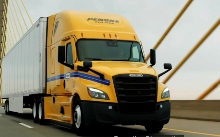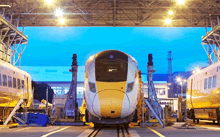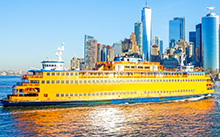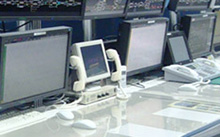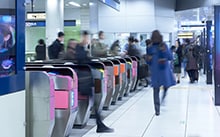The Daegu Urban Railway Line 3 Monorail System, which started service in Daegu Metropolitan City, a central metropolis in southeast Korea, is a new means of transit that can carry passengers anywhere north, south, east, or west within an hour, while helping to relieve traffic congestion and improve the urban environment. At the same time, it is even a new sightseeing attraction itself, as it has become a popular Daegu-area landmark.
In cities such as Daegu Metropolitan City, a central metropolis in southeast Korea and home to over 2.5 million people, the concentration of the population and an increasing number of automobiles has been causing severe traffic jams. This has put the city under pressure to find ways to ease traffic congestion and fix the problem of a lack of convenient transportation in the northern and southeastern parts of the city. To address this issue, the governments of Korea and Daegu Metropolitan City began planning to develop a light-rail network. As an alternative to subways, the two governments settled on introducing a monorail system, which entails relatively low construction cost and low environmental impact.
The Daegu Urban Railway Line 3 Monorail System is about 24 kilometers long, running from northwest to southeast in the city, connecting 30 stations. As the line runs from the center of the city out to the suburbs, the city's landscape required preservation, and construction had to be done in a way to minimize negative impact on traffic.
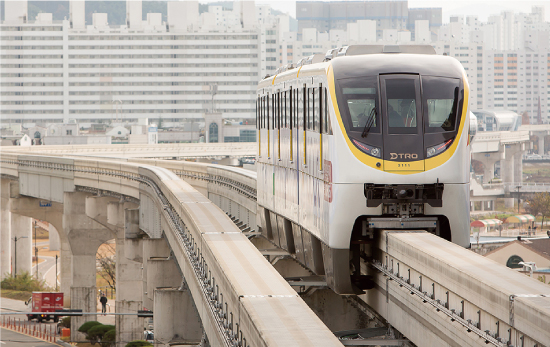
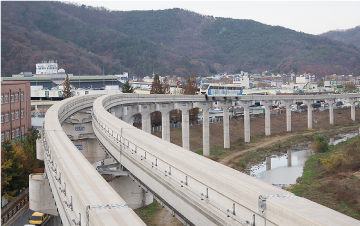
In Korea, since delivering cars for the Seoul Metropolitan Subway No. 1 Line, which began operating in 1974, Hitachi has been working to solve the problem of traffic congestion in Korea's major cities. Through these efforts, Hitachi has been highly acclaimed for environmentally friendly railway systems, boasting such achievements as reduced noise and dust; a catalogue of accumulated technologies covering transport capacity, construction cost, traffic congestion relief; and reliability. For these and other reasons, the straddle-type monorail system proposed by Hitachi was selected to be Korea's first monorail system.
In 2007, Hitachi established in Seoul, Korea a local subsidiary for its railway business: Hitachi Korea Railroad System Ltd. (now Hitachi Korea Ltd.). In 2008, Hitachi entered into a contract and received orders for key infrastructure components, including vehicles and signaling systems. The following year, Hitachi began working in cooperation with local partners to deliver the monorail system.
Aluminum alloy was adopted as the material for the cars of the Daegu Urban Railway Line 3 monorail manufactured by Hitachi. This has the advantages of being lightweight and durable while also being recyclable. In addition, a 30% reduction*1 in cost was achieved by using a beam-type monorail instead of slab system for the track. The beam-type is also favorable esthetically over the slab system because of its slimmer construction, a factor appreciated by passengers for the openness it imparts.*2
The Daegu Urban Railway Line 3 Monorail System, which began service in April 2015, has taken the lead in stable operation and in the modernization of public transportation. This reputation is bringing increasing numbers of visitors from around Korea and abroad to study and benchmark this system. Having been nicknamed the "Sky Rail," and having otherwise become a treasured part of the city as a vital attraction, Line 3 is making a tremendous contribution to Daegu's image.
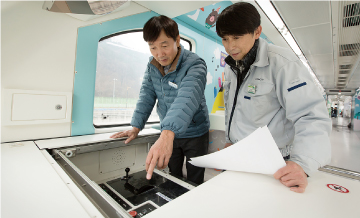
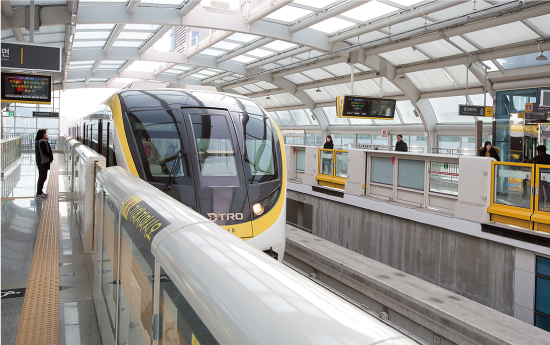
Daegu Metropolitan Transit Corporation, a railway-operating company, has profited greatly from the introduction of the Daegu Urban Railway Line 3 Monorail.
Lines 1 and 2 have a staff of from 9 to 12 people operating the stations. Stations on the new Line 3, however, benefitting from the adoption of ATO (Automatic Train Operation), a system that supports unmanned operation, are run by just three. Also, due to lightweight construction and improved durability, power consumption per kilometer was decreased by about 65% compared to Line 1 and about 80% compared to Line 2. Another advantage is one especially valued by railway employees: that of the many changes to their working environment brought about by the above-ground operation of the monorail.
For the year starting from April 2015, the Daegu Urban Railway Line 3 Monorail recorded a total ridership of over 24 million passengers and is currently used by an average of about 70,000 people per day.*3 Considerations for passenger safety include sprinkler-type fire extinguishers, a mechanism for enabling safe evacuation from elevated tracks, and the control of door opening and closing times so as to allow safe boarding and deboarding at crowded stations, such as Seomun Market, Sinnam, and Myeongdeok.*3 Other advanced technology includes the use of mist glass for the side windows, which automatically change from "transparent" to "blind" as the monorail runs through residential neighborhoods, ensuring privacy for people living along the line.
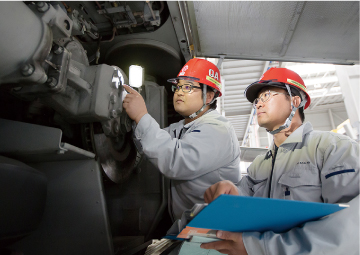
In Korea, Hitachi has been working to help solve the problem of traffic congestion ever since it first delivered trains for the Seoul Metropolitan Subway No. 1 Line, which began operating in 1974. With its opening, the Daegu Urban Railway Line 3 Monorail has attracted attention as a Daegu Metropolitan City landmark, contributing to the image of Daegu as a dynamic city. The building of new tourism infrastructure has also created demand in tourism, while the building of a city railway network that allows passengers to go anywhere north, south, east, or west in less than an hour is also contributing to the economic revitalization of Paldal-ro, Dalseong-ro, Myeongdeok-ro, and other older parts of the city.*3
By supplying high-performance railway systems, Hitachi aims to provide transit systems that deliver traffic congestion relief in Korea's major metropolitan areas alongside safety and convenience for the Korean people. In this and other ways, Hitachi will continue with its contributions to enriching the lives of those in urban areas.
Source:
Release Date: April 2017
Solutions By: Railway Systems Business Unit, Hitachi, Ltd.
